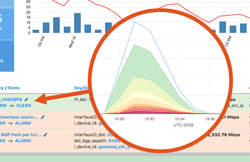Kentik Blog
























Out with the old, in with the new, or so it seems this week. Apple has a new data center, its first in China. Intel announced a new line of microprocessors. Ericsson announced a new network services suite for IoT. Also this week, Kentik’s survey from Cisco Live reveals network challenges affecting digital transformation. More after the jump.
Operating a network means staying on top of constant changes in traffic patterns. With legacy network monitoring tools, you often can’t see these changes as they happen. Instead you need a comprehensive visibility solution that includes real-time anomaly detection. Kentik Detect fits the bill with a policy-based alerting system that continuously evaluates incoming flow data. This post provides an overview of system features and configuration.
As one of 2017’s hottest networking technologies, SD-WAN is generating a lot of buzz, including at last week’s Cisco Live. But as enterprises rely on SD-WAN to enable Internet-connected services — thereby bypassing Carrier MPLS charges — they face unfamiliar challenges related to the security and availability of remote sites. In this post we take a look at these new threats and how Kentik Detect helps protect against and respond to attacks.
Verizon’s deal with Yahoo may still be on the minds of many, but Disney may be Verizon’s new big brand-of-interest. Also on acquisitions, Forrester’s CEO says Apple should buy IBM. Juniper Research released a list of the most promising 5G operators in Asia. And the UN released a list of countries with cybersecurity gaps. More after the jump…
Obsolete architectures for NetFlow analytics may seem merely quaint and old-fashioned, but the harm they can do to your network is no fairy tale. Without real-time, at-scale access to unsummarized traffic data, you can’t fully protect your network from hazards like attacks, performance issues, and excess transit costs. In this post we compare three database approaches to assess the impact of system architecture on network visibility.
This week Cisco made a series of product announcements, including intent-based networking for automation. NTT launched an SD-WAN. An open Amazon S3 server exposed millions of voters’ PII. A group proposed a way to reduce BGP route leaks. More after the jump…
NetFlow data has a lot to tell you about the traffic across your network, but it may require significant resources to collect. That’s why many network managers choose to collect flow data on a sampled subset of total traffic. In this post we look at some testing we did here at Kentik to determine if sampling prevents us from seeing low-volume traffic flows in the context of high overall traffic volume.
The NSA officially blamed North Korea for the WannaCry ransomware attacks. A Virginia school got creative to keep its students on fast broadband. Ericsson predicts a 5G user spike. The tabs versus spaces programmer debate continues. And the Kentik team advises on avoiding AWS downtime and offers skills for DevOps engineers to know. All that and more after the jump…
Telecom and mobile operators are clear on both the need and the opportunity to apply big data for advanced operational analytics. But when it comes to being data driven, many telecoms are still a work in progress. In this post we look at the state of this transformation, and how cloud-aware big data solutions enable telecoms to escape the constraints of legacy appliance-based network analytics.
The meaning of SDN changed. That is, if you’re working in Cisco’s Security Business. It means “security-defined networking,” which is where they’re focusing. SD-WAN is still hogging the spotlight, but CenturyLink says it’s “no quick fix.” Meanwhile, containers are a big part of AT&T’s network strategy. “Not everything is suited for virtual machines,” said AT&T’s CTO. More after the jump…









